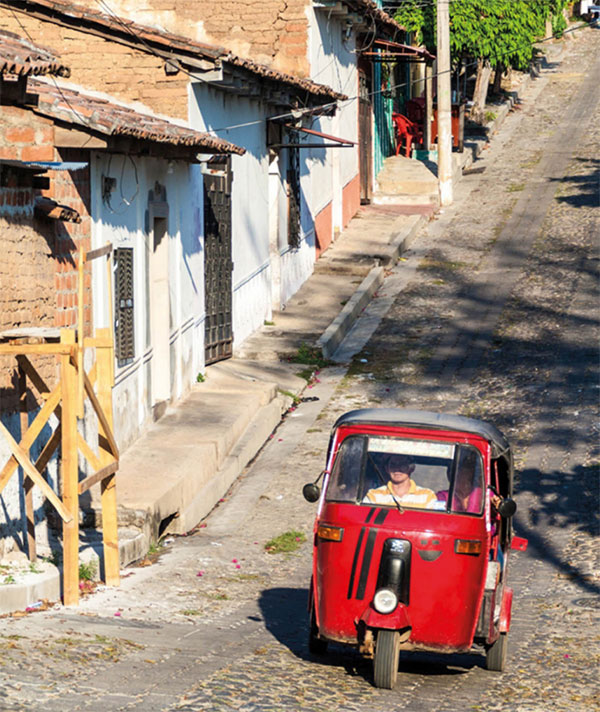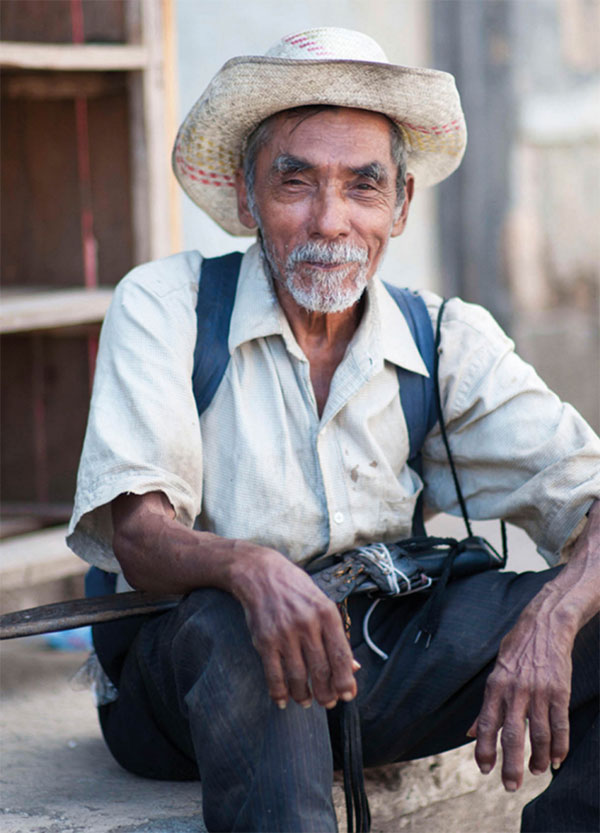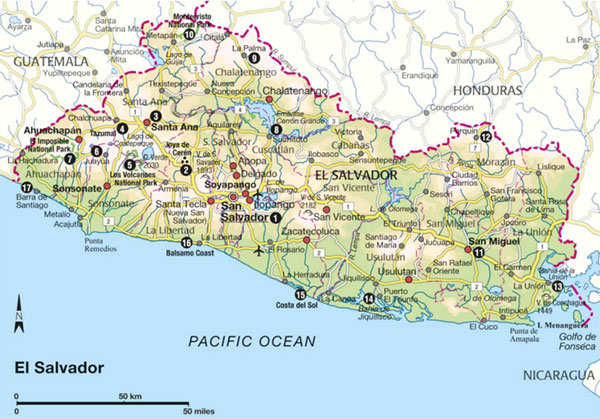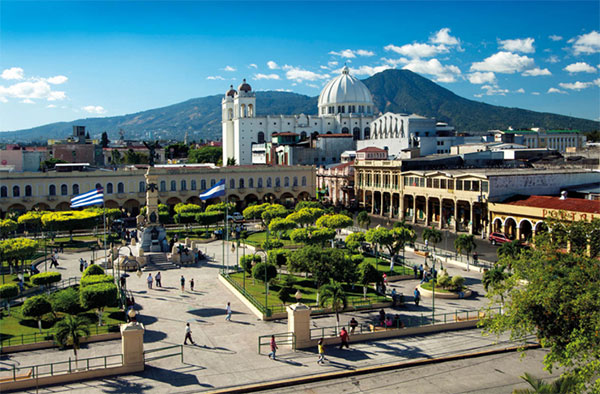EL SALVADOR
Famed surf breaks, hikes through untrammeled cloud forests, and exploring the Mayan Pompeii await the traveler looking for Central America’s next big thing.
Main Attractions
San Salvador
Joya de Cerén
Los Volcanoes National Park
Suchitoto
Montecristo National Park
Balsamo Coast
Despite frequent earthquakes and a tumultuous history that includes a brutal civil war, the tiny nation of El Salvador, smaller than Massachusetts, has one of the most robust economies in the region. A growing middle class is being fueled by the presence of multinational companies’ call centers. These are opportunistically hiring English-speaking deportees who have been affected by the US’s stepped-up immigration control efforts, a policy which, more soberingly, has also brought along an increase in gang activity.

Mototaxi on a street in Suchitoto.
Shutterstock
Central America’s smallest country has two distinct regions: the highlands, which make up most of the landscape; and the swelteringly hot Pacific lowlands along the coast. With a good network of roads, getting around is quite easy.
The country’s vibrant capital San Salvador can be found on the hot central plateau. It’s a city of contrasts, where the image of luxury shopping malls and American fast-food chains conflict with the rough, often crime-ridden barrios on the outskirts of town. Just to the north is the Salvadoran version of Antigua, Suchitoto, a laid-back, colonial country town with cobblestone streets, yet only a fraction of the tourists found in similar locations in neighboring countries.
Heading west from the capital, along the Ruta de las Flores and toward the Guatemalan border, a cluster of volcanoes such as Santa Anaz and Izalco have provided rich soil that provides ideal conditions for coffee plantations. The surrounding mountain ranges are dotted with small crater lakes and natural reserves like the Los Volcanoes and Montecristo national parks, which offer superb hiking and wildlife watching. The region can also claim the country’s most famous ruins at Joya de Cerén, a preserved 1,400-year old Mayan village long-covered in ash, similar to Italy’s Pompeii.

Local man in Perquín.
Getty Images
Along the coast, the mountains roll right into the ocean in places, while in others there are coastal plains, mangrove forests and estuaries. The Salvadoran Pacific is perhaps the region’s most underappreciated strip of sand and the golden and black volcanic beaches have attracted a growing surf community who take advantage of the breaks at Punta Roca and El Sunzal. The coast has it all, from large all-inclusive resorts to no-frills beach hostels with hammocks strung up between two palms.
The post-war era
In the Chapultepec Peace Accords that marked the end of El Salvador’s civil war in 1992, the size of the army was reduced and the National Police force was dissolved, as was the National Guard and other security forces. The former insurgent group known as the Farabundo Martí National Liberation Front, or FMLN, became one of El Salvador’s political parties, though they failed to gain much traction other than a strong showing in the capital. Three consecutive National Republican Alliance, or ARENA, candidates have pushed for the privatization of large state enterprises and other neoliberal policies.
Despite strong support, the FMLN’s continuing losses in presidential elections caused them to pick, a former journalist, Carlos Mauricio Funes Cartagena, to run as their candidate in the 2009 election. He won, becoming the first president of a leftist party in El Salvador’s history. His administration had some success; however, after FMLN candidate and former guerrilla leader Salvador Sánchez Cerén won the 2014 election, Funes came under scrutiny for corruption and sought asylum in Nicaragua.
A cycle of migration
One of the drivers of El Salvador’s burgeoning economy are the remittances sent by Salvadorans living abroad in the US, Canada, Mexico, Guatemala, Costa Rica, Australia, and Sweden. Estimates suggest that the two million Salvadorans living outside the country send an estimated $2 billion back to the country each year. However, during the administration of President Barack Obama, the US deported an estimated 150,000 undocumented Salvadorans who had been living in the US, a move that has shaken the already fragile nation.

The move has led to increased crime from the maras, or gangs, which had already been showing their teeth throughout the country. Law enforcement programs like La Mano Dura and Mano Superdura have done little to stop the violence. Then there are the deportees who had been living in the US since they were young children and have known no other life. They are strangers in their own land, though many who are perfectly bilingual are finding work in the call centers set up to service international corporations that have opened over the past decade. Earning higher wages than they could otherwise anticipate, they are participating in developing El Salvador’s domestic economy.
San Salvador and around
Nowhere are the divisions in Salvadoran society as clear as in San Salvador 1 [map] . Set at the base of green San Salvador volcano in the pleasant-sounding Valle de las Hamacas – so named by the Spaniards for the tectonic activity in the region – El Salvador’s sprawling capital is home to one third of the country’s entire population. Leafy suburbs where the nation’s wealthy live and the dizzying collection of multinational chains almost seem out of place compared to grittier parts of the city, like the sketchy eastern districts that should be avoided by tourists. For many, San Salvador is simply the port of arrival, a place for a nice dinner and a comfortable night’s sleep before heading out to the coast or into the mountains, neither of which are far away.
Centro Histórico
The city was founded in 1545 after resistance from the Pibil people stopped a capital from forming in Suchitoto to the north. Growing up around Plaza La Libertad, the city heard the first cries of independence from Spain in Central America in 1811 and 1814. Over the following decades, the city’s progress was fueled by profits from a rapidly growing coffee industry and many of the most famous palaces, churches, and theaters were built.

Plaza La Libertad in downtown San Salvador.
Getty Images